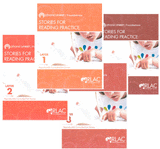Controlled Readers Improve Reading Success
Posted by Brainspring on 31st Jul 2014
Hi everyone,
I have been having a fantastic time this week putting on a training for a group of teachers. Teaching them reminded me of how important the oral reading component of a phonics lesson is and how critical choosing an appropriate text is for this purpose.
What do you try to keep in mind when selecting oral reading for your students?
Specific Purpose of Oral Reading in a Phonics Lesson
In the context of the Phonics First lesson, oral reading is primarily for the student to practice applying the skill or sound you just taught in reading. The oral reading you use as part of the phonics won’t be the only reading your student has during the day. In the classroom there will be many other opportunities to practice and instruct reading, such as during the core Language Arts program, Guided Reading groups, read-alouds and silent reading time. Keeping in mind that the student will have multiple reading experiences throughout the day, take the time to focus on a specific skill during the oral reading part of the phonics lesson. I like to use the analogy that controlled reader practice is like a musician practicing scales. Even though musicians may be advanced enough to play Beethoven, even the best musicians constantly and repeatedly practice the basics because repetitive practice makes skills become automatic. Automaticity is what our students need to develop as well.
Controlled Readers Set Students Up for Success
If you are using RLAC’s Phonics First program, then you have already set your student up for a successful reading experience with other parts of the lesson. They had word-level practice in the blending drill and reading dictation words, as well as connected text practice reading dictation sentences. To help ensure their reading experience is successful, choose a controlled reader to start with.
 Controlled readers contain only the skills that the student has been explicitly taught. This is great because it means the student will never run into a word that they don’t have the skills to decode! Students can then decode with less effort and move towards reading more fluently. What a great confidence boost! Students who struggle often find oral reading to be a daunting task. If you are using a controlled reader though, you can confidently assure them that they have the skills to be able to read every word in that passage. Your students get the reassurance that they will be able to successfully read the passage.
Controlled readers contain only the skills that the student has been explicitly taught. This is great because it means the student will never run into a word that they don’t have the skills to decode! Students can then decode with less effort and move towards reading more fluently. What a great confidence boost! Students who struggle often find oral reading to be a daunting task. If you are using a controlled reader though, you can confidently assure them that they have the skills to be able to read every word in that passage. Your students get the reassurance that they will be able to successfully read the passage.
As the teacher, you get the reassurance that you can expect them to read every word accurately. When reading a controlled reader, you should expect your student to read every word accurately. If they miscue on a word, ask them to sound it out and then read the sentence from the beginning. Controlled readers are one way Phonics First builds independent learners. Since the students have been taught all the skills in the passage, you can suggest a strategy to figure out an unknown word, but the student must apply the strategy themselves to read it. Instead of telling the student an unknown word, try suggesting an appropriate strategy like sounding it out or arm-tapping it.
Types of Controlled Readers
There are different kinds of controlled readers available and how controlled they are varies. If you are using Phonics First, I strongly (very strongly) recommend using the Phonics First Foundations Stories for Reading Practice. These are highly controlled to contain only the skills the student has learned in Phonics First up to the point of the lesson. Almost all of the lessons have a story designed to highlight the specific skill from that lesson. The reason I so strongly recommend these is because you can be certain that the student will not run into anything new or a skill they haven’t learned yet. This is fantastic for building confidence in struggling readers because they will always be able to apply a strategy to decode a word independently (You may need to guide them to apply a strategy.). Students feel awesome when the teacher doesn’t have to tell them the answer. 
Ideally, I would use a Phonics First story for the oral reading part of the lesson; then supplement with other types of controlled or decodable readers. Some other options are alphabet series books, S.P.I.R.E Readers, Reading Detective books, ect. You can check out different options in the RLAC Teacher’s Store (http://shop.rlac.com/student-readers/). These controlled readers will be less controlled than the Phonics First stories, but they will still offer decoding practice at an appropriate level.
What readers do you like to use for oral reading with phonics lessons?
What kinds of reading material have you found best suited for older students? Younger students?
Remember to like us on FB, follow us on Twitter and share us with your friends!
